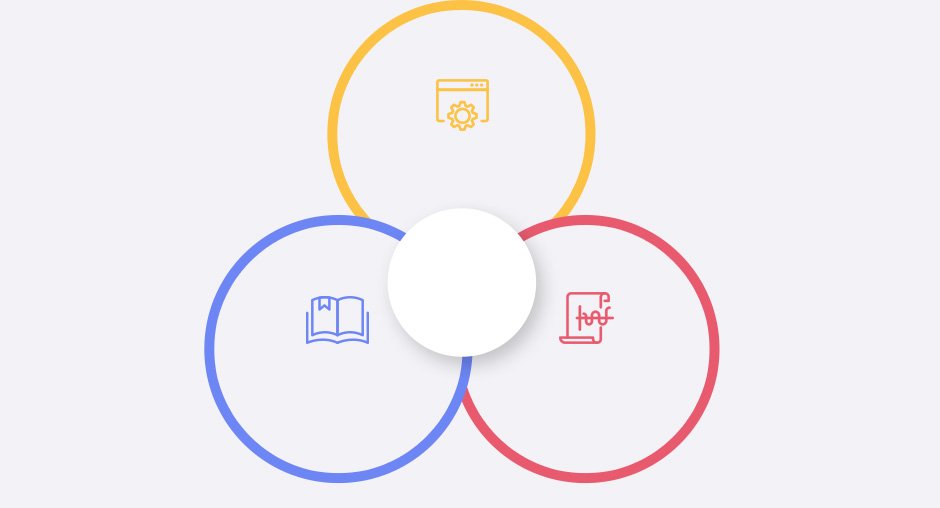Data Science
Research Areas
We analyze customer
patterns, tendencies and
preferences to
personalize financial
products.

Intro
The “era of massive data explosions” has already arrived. We are surrounded by mountains of
data to the point where the data produced over the past two years exceeds what was produced
throughout the history until then. This is why individuals, as well as companies, now see profits
through their use of data and related transactions.
Now, more than ever before, is the time to explore these data mountains to discover useful
information and new insights. The field of data science aims to find real (practical) value from
immense quantities of data and refine what is discovered until it can be applied for general use.
What is
Data Science?
Data science can be explained as the intersection of three areas: computer science, math and
statistics, and domain knowledge.
A data scientist is the person with these interdisciplinary abilities—well-informed in all three
areas. A diverse range of knowledge and insight in multiple fields, followed by the ability to
come up with creative ideas, is essential for those who work in data science

-
DATA
SCIENCE -
Computer
Science / IT -
Machine
Learning -
Domain / Business
Knowledge -
Traditional
Research -
Math and
Statistics -
Software
Development
HIT’s data science research aims to bring innovative financial services out of our data.
To achieve this, we utilize not only finance-related data but also data from outside the financial
sector. We strive to understand our customers from every aspect through their consumption
patterns and preferences throughout all specific types of financial products. Data science allows
HIT to provide new products and services that are the most suitable to each customer’s need.

DATA
SCIENCE
-
Feature
Extraction - Optimization
- Prediction
-
Recommen
-dation - Segmentation
1
Unsupervised
Learning
- Clustering
- · K-means Clustering
- · Hierarchical Clustering
- · Density Based Clustering
- Dimensionality Reduction
- · Non-negative Matrix Factorization
- · Principal Component Analysis
- · Linear Discriminant Analysis
- Association
- · Eclat Algorithm
- · Growth Algorithm
- · Apriori Algorithm
2
Supervised
Learning
- Classification
- · Support Vector Machine
- · Random Forest Classification
- · Decision Tree Classification
- Regression
- · Linear Regression
- · Ridge Regression
- · Random Forest Regression
3
Reinforcement
Learning
- · Trust Region Policy Optimization
- · Deep Q Network
- · Q-learning
Data analysis techniques become increasingly sophisticated and complex day by day.
At HIT, we secure the latest technologies to increase our potential to provide innovative services,
approaching problems with research techniques that have never been used before. To make this
possible, we make good use of HFG’s collective intelligence—created by combining the
knowledge of HIT data scientists and finance experts from both within and outside HFG.
Future Research
HIT aims to bring greater sophistication to HFG’s financial services through data science. To this
end, HIT data science has prioritized three areas for enhancing these financial services: customer
management, credit risk management, and work optimization.
Our goal is to create comprehensive but personalized financial services that can serve as a future
finance scenario, which can then predict what our customers will experience and span the full
range of sectors in the financial industry: banking, securities, credit cards, and insurance.
Customers can access the personalized services, which will be provided permanently. In the
future, finance will have evolved to the point that the products and services offered to the
customers are what they want, in the desired format and at the desired time.
Customer credit ratings and abnormal financial patterns are analyzed to establish an efficient
management system that can minimize credit and operational risks, which in turn allows
individuals and companies to prevent potential internal and/or external losses. We can also
automate the simple and repetitive tasks in the financial sector to enhance work-related
convenience. The manpower that consequently becomes available can then be re-directed to
new tasks which add much higher value.
The competitiveness of the future finance industry will rely almost entirely on increasing the
value of customer experience. HIT is committed to tirelessly improving this value through data
science research.
